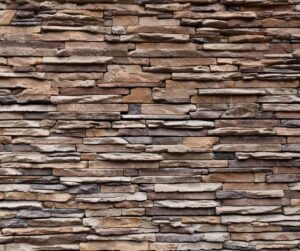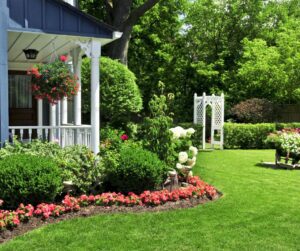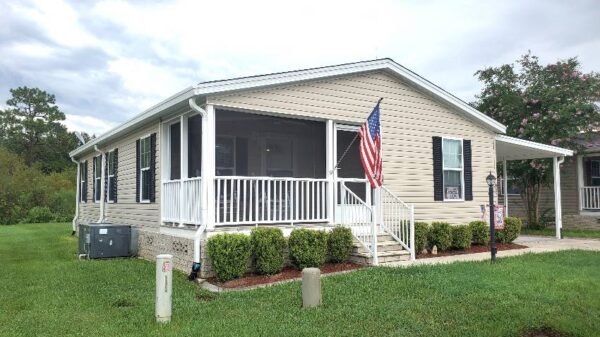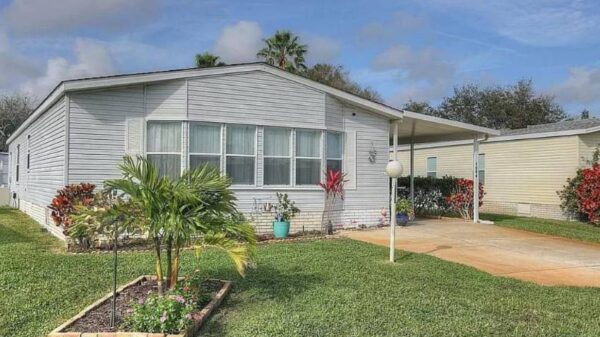Table of Contents
Skirting for Manufactured Homes
Manufactured home skirting, or underpinning, is essential for both aesthetic and functional purposes. Skirting not only completes the look of your manufactured home but also protects the foundation from weather elements, pests, and debris. Here’s an overview of popular skirting for manufactured homes, each with its unique benefits, to help you make an informed choice for your home.
1. Vinyl Skirting
Vinyl skirting is the most popular choice for manufactured homes due to its affordability, versatility, and ease of installation. While it may not be the most durable option, vinyl provides a good balance between cost-effectiveness and functionality.
Material Composition and Types
Vinyl skirting panels are made from polyvinyl chloride (PVC), a durable plastic material commonly used for exterior siding and fencing. There are different grades of vinyl skirting, with some designed to withstand more extreme conditions or resemble other materials, such as wood or stone. These higher-quality options come with UV resistance, preventing fading and making the skirting last longer.
Installation Techniques
Vinyl skirting installation is relatively straightforward and can be done by most homeowners without professional assistance. Here’s a general overview of the installation steps:
- Measure and Plan: Begin by measuring the perimeter of your home and deciding on the height of the skirting panels needed. Vinyl panels come in various lengths, typically adjustable for most manufactured home heights.

- Create a Frame: Secure a base track along the bottom of your manufactured home, where the panels will fit. Ensure the base is level to create an even foundation.
- Attach Panels: Insert the vinyl skirting panels into the base track, ensuring each piece locks securely into place with the previous panel. Some vinyl skirting systems have interlocking mechanisms for added stability.
- Top Rail Installation: Once the panels are in place, secure them with a top rail, completing the look and adding stability.
- Ventilation and Access Points: It’s important to add ventilation points throughout the skirting to prevent moisture buildup under the home. Access doors are also common, allowing easy access to plumbing or other utilities under the home.
Styles and Aesthetic Options
Vinyl skirting is available in a wide array of colors, textures, and finishes, allowing homeowners to match their skirting to the home’s exterior design. Popular styles include:
- Smooth Panels: These provide a clean, modern look and are often the most affordable.
- Wood Grain or Faux Wood: For those looking to create a rustic or traditional aesthetic, some vinyl skirting mimics the look of wood.
- Stone and Brick Look-Alikes: Premium vinyl skirting options mimic natural materials like stone or brick, giving a high-end appearance at a fraction of the cost.
These options give homeowners flexibility to find a style that complements their manufactured home’s exterior, providing curb appeal without significant expense.
Advantages of Vinyl Skirting
- Cost-Effective: Vinyl skirting is one of the most affordable skirting materials available, making it ideal for homeowners on a budget.
- Easy Installation: Lightweight and easy to handle, vinyl skirting can often be installed as a DIY project.
- Low Maintenance: Vinyl requires little upkeep; typically, an occasional wash with soap and water is enough to keep it looking fresh.
- Weather Resistant: High-quality vinyl skirting is designed to withstand rain, humidity, and moderate temperature changes without warping or cracking.
- Wide Range of Styles: With numerous colors and textures available, vinyl skirting can match various design preferences, from classic to modern.
Drawbacks of Vinyl Skirting
- Susceptible to Damage in Extreme Cold: In very cold temperatures, vinyl can become brittle and may crack if subjected to impact.
- Limited Durability: Compared to heavier materials like concrete or metal, vinyl is less durable and may need replacement sooner, especially in harsh climates.
- Wind Vulnerability: High winds can sometimes dislodge vinyl panels if they aren’t securely installed, making it less suitable for areas prone to strong storms.
Maintenance Tips
- Clean Regularly: Washing vinyl skirting with a garden hose and mild detergent can remove dirt, mold, and grime, keeping it looking new.
- Inspect Annually: Check for cracks, gaps, or loose panels each year, especially after severe weather. Replace or repair damaged panels to prevent further wear.
- Protect from Lawn Equipment: Avoid hitting the skirting with lawnmowers or other outdoor equipment to reduce the risk of cracking.
- Check for Pests: Although vinyl skirting helps prevent pests, occasional inspection for signs of insects or rodents is wise, as gaps in the skirting can become entry points.
Climate Considerations
Vinyl skirting performs best in moderate climates where temperature fluctuations are minimal. In regions with extremely hot summers, UV rays may cause fading over time. If you live in an area with very cold winters, consider using a thicker grade of vinyl skirting that’s better suited for extreme temperatures. Some homeowners in colder climates also reinforce their skirting with insulation or foam backing, which helps with temperature regulation beneath the home and adds stability to the vinyl panels.
2. Metal Skirting: Durable and Long-Lasting
Metal skirting, typically made from materials like aluminum or steel, is a strong, long-lasting choice for manufactured homes. Known for its resistance to impact, pests, and weather, metal skirting is ideal for homeowners seeking a durable solution.
Materials and Types of Metal Skirting
Metal skirting generally comes in two main materials, each with its unique properties:
- Aluminum: Aluminum is lightweight, rust-resistant, and easy to work with, making it a popular choice. It’s suitable for homes in wet or humid climates, as it won’t corrode over time.
- Steel: Steel is heavier and offers increased strength and security. Galvanized steel (coated to prevent rust) is particularly popular for skirting as it provides durability and can withstand more impact than aluminum.
Both materials are available in various thicknesses, with thicker panels providing better insulation and increased resistance to warping or denting. Metal skirting can come in different finishes, including smooth or corrugated surfaces, to provide a custom look.
Types of Metal Skirting Styles
Metal skirting is available in several styles and finishes:
- Smooth Finish: A clean, minimalist look that gives a modern appearance.
- Corrugated or Ribbed: Ribbed or corrugated metal skirting has small grooves or ridges that add strength to the panels and offer a textured appearance.
- Perforated Metal: This style has tiny perforations for ventilation, allowing airflow while still providing a protective barrier.
Metal skirting is also available in various colors, typically in neutral shades like gray, white, or tan, which are easy to match with most manufactured home exteriors.
Installation Process for Metal Skirting
Installing metal skirting is generally more labor-intensive than other materials like vinyl, but the process is still manageable, especially with the right tools:
- Measure and Cut Panels: Start by measuring the perimeter and height of your home to determine the required panel sizes. Many metal skirting panels can be custom-cut to fit the specific dimensions of your home.
- Prepare the Ground: Create a level, compacted area along the base of your home for a stable foundation. Some installations may require a footer or a shallow trench to prevent movement.
- Secure Bottom Track: Similar to vinyl skirting, metal skirting uses a bottom track that anchors the panels. This track is typically screwed or nailed into the base of the home’s foundation or frame.
- Install Panels: Attach the metal panels to the bottom track and secure them using screws or rivets. Panels are often overlapped to ensure no gaps are left, protecting against pests and weather.
- Top Rail Installation: Secure a top rail over the panels to complete the installation, adding stability and a polished look.
- Ventilation and Access Doors: Metal skirting can restrict airflow, so adding vents throughout is essential to prevent moisture buildup under the home. An access door can also be installed for easy entry to plumbing or other utilities beneath the house.
Benefits of Metal Skirting
Metal skirting provides a range of benefits that make it a popular choice for manufactured homeowners seeking long-lasting durability and protection:
- Extreme Durability: Both steel and aluminum are highly durable and can withstand impacts, harsh weather, and temperature changes without warping, cracking, or rotting.
- Pest and Fire Resistance: Metal naturally resists pests like rodents and insects, which often find ways into softer materials. Additionally, metal is non-flammable, adding an extra layer of safety for homes in fire-prone areas.
- Weather Resistance: Metal skirting performs well in a variety of climates, standing up to wind, rain, and snow without damage. It’s especially suitable for areas that experience severe weather.
- Low Maintenance: Once installed, metal skirting requires minimal upkeep. Aluminum, in particular, does not rust, and both materials are easy to clean with water and a mild detergent.

- Security: Metal skirting offers a robust barrier, providing added security against intruders and helping prevent unwanted access under the home.
Drawbacks of Metal Skirting
While metal skirting has many advantages, there are some considerations to keep in mind:
- Higher Cost: Metal skirting is more expensive than vinyl, especially if you choose high-grade or custom-finished panels. However, its long lifespan can make it cost-effective over time.
- Difficult Installation: Metal panels are heavier and require special tools like a drill, rivet gun, or tin snips for cutting. DIY installation can be more challenging than with vinyl or lattice skirting.
- Susceptibility to Dents: While durable, metal can still dent or bend with significant impact, such as from flying debris or lawn equipment.
- Heat Retention: Metal absorbs heat, which can warm the space beneath the home. In hot climates, this could potentially affect the temperature under the house, although ventilation can help mitigate the issue.
Maintenance Tips for Metal Skirting
To ensure your metal skirting remains in top condition, here are some maintenance tips:
- Inspect for Rust: For steel skirting, look for signs of rust, especially in humid or wet climates. Galvanized steel is less likely to rust, but regular checks can prevent corrosion issues.
- Clean Regularly: Wash the skirting periodically to remove dust, dirt, and debris. Use a mild detergent with water and a soft brush or cloth to prevent scratching.
- Tighten Loose Fasteners: Over time, screws or rivets may loosen due to vibration or weather. Check the fasteners periodically and tighten any that seem loose to keep the panels secure.
- Protect from Lawn Equipment: Avoid using lawn equipment too close to the skirting to prevent dents or damage. Metal skirting can dent if hit with force.
Climate Considerations
Metal skirting performs well in a variety of climates, but certain factors should be considered:
- Cold Climates: Metal can withstand freezing temperatures without cracking or becoming brittle. However, adding insulation or using foam backing behind the panels can help prevent drafts under the home.
- Hot Climates: In areas with intense heat, metal skirting can get hot to the touch, which may raise the temperature under your home. Adding ventilation or using perforated panels can reduce this effect.
- Humid or Coastal Areas: Aluminum is ideal for humid or coastal regions, as it doesn’t rust like steel. For steel skirting, opt for galvanized panels to minimize corrosion.
3. Brick or Block Skirting: A Permanent and High-End Option
Brick and block skirting is an elegant, permanent skirting choice that provides a solid foundation look for manufactured homes. This type of skirting adds a sense of permanence and enhances curb appeal, making it a favorite for those looking for a more traditional or upscale appearance.
Material Choices: Brick vs. Concrete Block
Brick and concrete block are the primary materials used for this type of skirting, each with unique characteristics:
- Brick Skirting: This option provides a classic, traditional look that gives manufactured homes a “real home” appearance. Bricks come in various colors, textures, and finishes, allowing homeowners to match the skirting to the home’s exterior.
- Concrete Block Skirting: Concrete blocks, sometimes called “cinder blocks,” offer a similar aesthetic to brick but at a lower cost. Concrete blocks are larger than bricks, which makes installation slightly faster, and they can be painted or finished with stucco for added visual appeal.
Both brick and block skirting require a concrete foundation or footer to ensure stability. The choice between brick and concrete block often comes down to budget, aesthetic preference, and desired durability.
Installation Process
Brick or block skirting is one of the more involved installation processes, typically requiring professional expertise due to the need for a stable foundation and masonry skills. Here’s an overview of the general steps involved:
- Preparing the Foundation: Brick and block skirting requires a level, concrete foundation to support the weight. A footer is poured around the perimeter of the manufactured home, creating a solid base for the masonry work.
- Laying the Bricks or Blocks: Once the foundation has set, bricks or blocks are laid in a staggered pattern, with mortar applied between each unit to hold them in place. Careful alignment ensures the skirting looks uniform and stable.
- Creating Vents and Access Points: To prevent moisture buildup under the home, ventilation gaps are left in specific areas. These vents can be covered with vent covers or grates to maintain airflow while keeping out pests. Access doors are also included in the skirting for entry into the crawlspace for maintenance or repair work.
- Finishing Touches: Once the brick or block skirting is complete, mortar is cleaned from the surface, and any final adjustments are made. Some homeowners choose to seal the brick or block to add weather protection and a polished finish.
Benefits of Brick and Block Skirting
Brick and block skirting offers several advantages that make it a highly desirable option for homeowners seeking a long-lasting, aesthetically appealing solution:
- High Durability: Brick and block are exceptionally strong and durable, withstanding impacts, weather extremes, and everyday wear and tear without cracking, warping, or rotting.
- Permanent and Secure: Once installed, brick and block skirting offers a permanent solution that requires minimal maintenance over time. Its solid structure also adds an extra layer of security against pests and unauthorized access.
- Enhanced Insulation: Brick and block skirting provides natural insulation, which helps maintain a stable temperature beneath the home. This can be especially beneficial in colder climates, reducing drafts and heat loss.
- Curb Appeal and Resale Value: Brick and block skirting gives manufactured homes a high-end, finished look that can boost curb appeal. The perception of permanence can increase the home’s resale value, making it a worthwhile investment.
- Customizable Aesthetics: With a variety of brick colors and finishes available, homeowners can select a style that complements their home’s exterior. Concrete blocks can be painted, finished with stucco, or even textured for a custom look.
Drawbacks of Brick and Block Skirting
While brick and block skirting offer many advantages, there are some considerations to keep in mind:
- High Initial Cost: Brick and block skirting is one of the most expensive skirting options due to the materials, labor, and foundation requirements. The initial investment can be significant, although it often pays off in terms of longevity and durability.
- Complex Installation: This type of skirting is labor-intensive and generally requires a professional masonry team to ensure proper alignment, stability, and ventilation.
- Permanent Structure: Brick and block skirting are difficult to remove, making this option less ideal if you plan to move your manufactured home in the future. This type of skirting is best suited for homes that are permanently installed.
- Longer Installation Time: Due to the involved installation process, it may take several days or even weeks to complete, depending on the size of the home and weather conditions.
Maintenance Tips for Brick and Block Skirting
One of the benefits of brick and block skirting is its low maintenance requirements. However, to ensure it remains in optimal condition, consider these maintenance tips:
- Inspect for Cracks: Over time, small cracks may appear in the mortar or blocks, especially in areas with frequent freeze-thaw cycles. Check for cracks annually and repair as needed to prevent moisture intrusion and structural weakening.
- Clean Occasionally: Dirt, moss, or algae can build up on brick and block skirting, especially in damp or shaded areas. Use a gentle pressure wash or a mixture of water and mild detergent to remove grime. Avoid harsh chemicals that could damage the mortar.
- Seal for Added Protection: Applying a water-resistant sealant to the brick or block surface can provide extra protection against water absorption, staining, and fading. Sealing is typically recommended every few years, depending on your climate.
- Check Vents and Access Points: Ensure that vents are clear of debris and working properly to prevent moisture buildup under the home. Verify that access doors are secure and in good condition.
- Monitor for Pests: While brick and block skirting provides excellent pest resistance, periodic checks for signs of insects or rodents can help you catch any issues early.
Climate Considerations
Brick and block skirting is ideal for a variety of climates but offers particular advantages in colder and more temperate regions due to its natural insulation and resistance to weather:
- Cold Climates: Brick and block skirting’s thermal mass helps retain heat, keeping the area under the home warmer in winter. This can reduce heating costs and prevent cold drafts from entering the home.

- Hot Climates: Brick and block materials don’t retain excessive heat, so they help regulate temperatures under the home even in warmer climates. This also helps reduce the workload on your HVAC system, improving energy efficiency.
- Wet and Humid Climates: Brick and block skirting are highly resistant to moisture, making them suitable for humid regions. When properly sealed, they are less susceptible to water damage, mold, and mildew compared to other skirting options.
4. Concrete Skirting: Sturdy and Insulating
Concrete skirting, sometimes referred to as concrete panel skirting or concrete perimeter skirting, offers a high level of durability and a permanent foundation-like appearance. Known for its strength, concrete skirting is ideal for homeowners who want a long-lasting solution that also adds a stable, finished look to their manufactured home.
Types of Concrete Skirting
There are a few different types of concrete skirting options, each with its own benefits and applications:
- Concrete Panels: Precast concrete panels are one of the most common forms of concrete skirting. These panels are poured, cured, and shaped in a factory setting, then transported to the site for installation. They’re designed to fit together seamlessly, creating a smooth and uniform appearance around the base of the home.
- Poured Concrete Skirting: In this approach, concrete is poured directly into forms on-site, creating a custom-fit skirting solution. Poured concrete skirting is highly durable and has no seams, but it requires more labor and is often more expensive than precast panels.
- Cement Board Skirting: Although technically not the same as full concrete, cement board skirting offers a lighter-weight option made from a blend of cement and fiberglass. Cement board panels can resemble traditional concrete but are generally easier to handle and install.
- Stucco Over Concrete Block: Another popular style involves using concrete blocks as the primary material, then applying a stucco finish to give the appearance of solid concrete. This is a budget-friendly way to achieve a concrete-like look with added texture and color options.
Installation Process
The installation of concrete skirting varies depending on whether you’re using precast panels or poured concrete. Here’s an overview of the general process for each method:
- Prepare the Foundation: Concrete skirting requires a stable, level foundation to ensure it remains intact over time. For poured concrete or block skirting, a footer or shallow trench is typically dug around the home’s perimeter, which provides a base for the concrete.
- Install Base Track (For Precast Panels): If you’re using precast concrete panels, a metal or concrete track is often placed at the bottom to hold the panels securely in place. The panels are then inserted into this track, ensuring stability and alignment.
- Pour or Set Panels: For poured concrete, concrete is poured into wooden or metal forms along the base of the home, creating a seamless wall as it sets. With precast panels, each panel is individually placed and secured, then joined with neighboring panels to form a complete skirt around the home.
- Add Finishing Touches: The surface can be finished with paint, stucco, or other materials to enhance the appearance. Many homeowners also add access doors or vents to provide entry to the crawlspace and ensure proper airflow under the home.
Benefits of Concrete Skirting
Concrete skirting offers numerous advantages, making it a highly attractive option for long-term homeowners:
- Durability: Concrete is one of the most durable skirting materials, capable of withstanding harsh weather, impact, and extreme temperatures without cracking or warping.
- Permanent Foundation Look: Concrete skirting creates the appearance of a permanent foundation, giving manufactured homes a more traditional and upscale look. This can enhance curb appeal and potentially increase property value.
- Excellent Insulation: Concrete has a high thermal mass, meaning it absorbs and retains heat. This helps regulate the temperature under your home, keeping it warmer in winter and cooler in summer, which can improve energy efficiency.
- Fire and Pest Resistance: Concrete is naturally resistant to fire and pests, offering added protection and peace of mind for homeowners.
- Low Maintenance: Once installed, concrete skirting requires minimal maintenance. Unlike other materials, it doesn’t rot, rust, or degrade over time, making it a good long-term investment.
Drawbacks of Concrete Skirting
While concrete skirting has many strengths, there are some potential downsides to consider:
- High Initial Cost: Concrete skirting is one of the more expensive skirting options due to the cost of materials and labor involved. However, the longevity of concrete often offsets this initial investment over time.
- Challenging Installation: Installing concrete skirting can be labor-intensive and often requires professional installation. This can increase costs and make it a more involved project than other skirting types.
- Permanent Structure: Once installed, concrete skirting is difficult to remove, making it less suitable for homeowners who may want to relocate their manufactured home in the future.
- Weight Considerations: Concrete is a heavy material, and some manufactured homes may require additional support or reinforcements to handle the weight of the skirting.
Maintenance Tips for Concrete Skirting
Concrete skirting is low-maintenance, but some periodic upkeep can help it last even longer:
- Inspect for Cracks: Over time, small cracks may form due to shifts in the ground or freeze-thaw cycles. Inspect the skirting annually and seal any cracks with concrete filler to prevent moisture intrusion.
- Clean Occasionally: Dirt, algae, or mildew can build up on concrete surfaces, especially in damp areas. Use a gentle pressure washer or a mixture of water and mild detergent to clean the surface.
- Seal if Needed: In regions with heavy rain or high humidity, applying a concrete sealant every few years can help protect the skirting from moisture and stains.
- Check for Ventilation: Ensure that any vents remain unobstructed to prevent moisture buildup under the home, which can lead to mold or mildew.
Climate Considerations
Concrete skirting performs well in a range of climates and offers specific benefits depending on the region:
- Cold Climates: Concrete skirting’s thermal mass helps retain heat, reducing cold drafts and keeping the area under the home warmer. In extremely cold regions, you may also consider adding insulation behind the concrete panels for added protection.
- Hot Climates: Concrete does not retain excessive heat, making it suitable for warm climates where temperature regulation is essential. It can help keep the underside of the home cooler in hot weather, reducing strain on your cooling system.
- Wet or Humid Climates: Concrete is naturally moisture-resistant and doesn’t rot, making it ideal for areas with high humidity or heavy rainfall. Sealing the concrete can provide extra protection and prevent water from seeping in.
Additional Aesthetic and Functional Enhancements
Concrete skirting can be customized in various ways to match your home’s exterior style and improve its functionality:
- Stucco Finish: Applying a stucco finish to concrete skirting can add texture and color, creating a Mediterranean or Southwestern look.
- Painted Concrete: Concrete panels can be painted to match or complement the color of your home, giving a cohesive and polished appearance.
- Masonry Accents: For an upscale look, consider adding decorative stone or brick accents along the base or corners of the concrete skirting.
- Access Doors: Adding one or more access doors provides easy entry to the crawlspace beneath the home for plumbing or maintenance work. These doors can be integrated seamlessly into the skirting design.
5. Foam Insulated Skirting: Energy-Efficient and Protective
Foam-insulated skirting is designed with energy efficiency in mind, providing an additional layer of insulation to help regulate temperatures beneath manufactured homes. This type of skirting is ideal for homeowners who want to improve their home’s energy efficiency, lower heating and cooling costs, and enhance year-round comfort.
Material Composition and Types of Foam Insulated Skirting
Foam-insulated skirting combines durable exterior materials with an inner layer of insulating foam. The foam is typically made from expanded polystyrene (EPS) or extruded polystyrene (XPS), both of which are known for their high insulation properties and resistance to moisture.
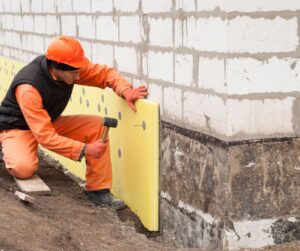
There are several types of foam-insulated skirting available, with variations in exterior materials, foam thickness, and R-value (a measure of insulation effectiveness):
- Vinyl-Faced Foam Skirting: This is a popular option that combines a durable vinyl exterior with foam insulation behind it. The vinyl provides weather resistance and can be manufactured in various colors and textures to match the home’s exterior.
- Metal-Faced Foam Skirting: Metal skirting with foam insulation offers increased durability and weather resistance, especially in areas with severe weather. Metal can be more impact-resistant than vinyl, and its foam backing provides added thermal insulation.
- Rigid Foam Panels: In some cases, rigid foam panels without a decorative exterior are used as skirting. These panels are highly insulating and can be installed with a protective finish, such as paint or stucco, to add durability.
The thickness of the foam layer varies by product, with thicker panels providing higher R-values. Homeowners in colder climates often choose thicker panels to increase insulation and reduce heat loss.
Insulation Properties and R-Value
The primary purpose of foam-insulated skirting is to reduce heat transfer between the area beneath the home and the outside environment. The foam insulation’s R-value indicates its thermal resistance, with higher R-values providing better insulation. Foam-insulated skirting can significantly reduce heat loss in winter and help keep the home cooler in summer, improving energy efficiency and lowering utility costs.
Typical foam-insulated skirting panels have R-values ranging from R-5 to R-10, although some premium options may offer even higher insulation. In particularly cold regions, these R-values can make a substantial difference in maintaining consistent temperatures and reducing drafts.
Installation Process
Foam-insulated skirting is generally straightforward to install, although it may require additional bracing or supports due to its thickness and insulation properties. Here’s a general outline of the installation process:
- Measure and Plan: Start by measuring the perimeter and height of your manufactured home to determine the size and quantity of foam-insulated panels needed.
- Prepare the Ground: Create a level base by clearing debris and compacting the soil around the foundation. Some homeowners install a bottom rail or track to secure the panels.
- Install Panels: Attach the foam-insulated panels vertically along the home’s perimeter, securing them to the frame with screws or clips. Each panel should be tightly fitted to prevent gaps that could allow drafts.
- Seal Joints and Edges: To maximize insulation, seal the joints between panels with weatherproof tape or caulk. This prevents air infiltration and enhances the skirting’s effectiveness.
- Add Top and Bottom Rails: Top and bottom rails or channels are often used to add stability and a finished appearance. These rails can help hold the panels in place and protect them from movement.
- Install Vents and Access Doors: Although foam-insulated skirting is designed to reduce airflow, adding a few strategically placed vents can prevent moisture buildup. An access door should also be installed for maintenance access to the crawlspace.
Benefits of Foam-Insulated Skirting
Foam-insulated skirting offers numerous advantages, especially for homeowners in climates with significant temperature fluctuations:
- Energy Efficiency: The foam insulation helps reduce heat transfer, improving the home’s energy efficiency. This can lead to lower heating costs in winter and reduced cooling expenses in summer, making the home more comfortable year-round.
- Improved Temperature Regulation: Foam-insulated skirting helps maintain a more stable temperature under the home, reducing cold drafts and protecting pipes from freezing in winter. This insulation also helps keep the area cooler in hot weather.
- Moisture Resistance: Foam insulation materials like EPS and XPS are resistant to moisture, which helps prevent mold and mildew under the home. The outer material, whether vinyl or metal, also protects against water intrusion.
- Noise Reduction: The foam insulation acts as a sound barrier, reducing noise from outside. This is particularly beneficial if the home is near a busy road or noisy area.
- Added Protection Against Pests: Foam-insulated skirting creates a solid barrier, helping to keep out rodents, insects, and other pests that might otherwise find entry points under the home.
Drawbacks of Foam-Insulated Skirting
While foam-insulated skirting offers many benefits, there are some drawbacks to consider:
- Higher Cost: Foam-insulated skirting is more expensive than basic vinyl or lattice skirting due to the added insulation layer. However, the potential energy savings can help offset this cost over time.
- Less Impact Resistance: Foam panels can be susceptible to damage from impacts, such as lawn equipment or debris. Metal-faced options offer more durability, but they may still require occasional repairs.
- Potential Moisture Trapping: While foam insulation is moisture-resistant, it can still trap moisture if not properly vented. This is particularly important in humid regions where moisture buildup can lead to mold or mildew.
Maintenance Tips for Foam-Insulated Skirting
Proper maintenance helps extend the lifespan of foam-insulated skirting and ensures it performs optimally:
- Inspect Annually: Check for any signs of damage, such as cracks, dents, or gaps between panels, especially after extreme weather. Repair or replace damaged panels as needed to maintain insulation.
- Clean Occasionally: Use a mild detergent and water to clean the exterior surface, removing dirt or algae. Be gentle to avoid damaging the foam layer beneath.
- Check Seals and Vents: Ensure that all seams and joints are properly sealed, and that vents are unobstructed to prevent moisture buildup. Sealing gaps helps maintain energy efficiency and keeps out pests.
- Protect from Impact: Be cautious when using lawn equipment or other tools near the skirting, as foam-insulated panels can dent or break with strong impact.
Climate Considerations
Foam-insulated skirting performs well in a variety of climates, particularly in regions with extreme temperatures:
- Cold Climates: The insulating properties of foam skirting are ideal for colder regions, as they help prevent cold air from entering the crawlspace and reduce the risk of frozen pipes. Higher R-value panels are especially useful in these climates for added protection.
- Hot Climates: Foam-insulated skirting helps keep the underside of the home cooler, reducing heat buildup and providing better temperature regulation. This can also reduce the strain on your HVAC system during summer.
- Humid Climates: In areas with high humidity, foam-insulated skirting helps prevent moisture from entering the crawlspace. However, it’s essential to add a few vents to allow airflow and reduce the risk of mold and mildew.
Aesthetic and Functional Enhancements
Foam-insulated skirting is available in a range of styles and finishes, allowing homeowners to achieve both functional and aesthetic goals:
- Color and Texture Options: Foam-insulated skirting comes in various colors, so you can match or complement your home’s exterior. Some panels mimic natural materials like stone or brick, adding visual appeal.
- Stucco or Stone Finish: For a high-end look, consider foam-insulated panels with a stucco or stone-like finish. These decorative options can enhance curb appeal while maintaining energy efficiency.
- Additional Insulation Layers: In very cold climates, some homeowners add extra insulation or backing behind foam-insulated skirting to increase R-value and create a more robust thermal barrier.
6. Cement Board Skirting: Durable and Versatile
Cement board skirting is a highly durable and weather-resistant option for manufactured homes. Known for its strength and versatility, cement board combines cement with fiberglass for a material that is both lightweight and resilient. It provides a solid barrier that enhances the home’s stability and gives it a more permanent, traditional appearance.
Material Composition of Cement Board Skirting
Cement board is made from a combination of cement, cellulose fibers, and sometimes sand. This mixture is pressed and cured to create panels that are lightweight, water-resistant, and resistant to warping, rotting, and pests. Cement board skirting panels are available in various thicknesses and sizes, typically ranging from 1/4 inch to 1/2 inch thick.
Cement board is often finished with a protective outer layer or can be painted, making it suitable for various aesthetic preferences. Some cement boards are textured to mimic the appearance of stucco, brick, or stone, offering a range of design options for homeowners.
Types of Cement Board Skirting
Cement board skirting comes in different styles and finishes, giving homeowners flexibility in choosing an option that suits their needs:
- Smooth Finish: This type of cement board has a clean, smooth finish that can be painted or left in its natural color for a minimalist look. It’s ideal for those who want a simple, modern appearance.
- Textured Finish: Textured cement board panels can mimic the look of stucco, brick, or stone, adding visual interest and enhancing curb appeal. These panels are pre-textured during manufacturing, providing a finished look without additional work.
- Primed or Pre-Painted Panels: Some cement board panels come pre-primed or pre-painted, making installation faster and easier. These panels can be painted in custom colors to match or complement the home’s exterior.
Benefits of Cement Board Skirting
Cement board skirting offers a variety of advantages, making it a popular choice for homeowners seeking durability and style:
- High Durability: Cement board is resistant to weather, impact, moisture, and temperature fluctuations. Unlike wood or vinyl, it won’t warp, rot, or become brittle over time, making it a long-lasting skirting option.
- Fire Resistance: Cement board is non-combustible, providing an added layer of protection against fire. This is particularly beneficial in fire-prone areas.
- Moisture and Mold Resistance: The cement and fiberglass composition resists moisture absorption, preventing mold, mildew, and rot. This makes it ideal for areas with high humidity or frequent rainfall.
- Pest Resistant: Cement board is impervious to pests like termites and rodents, ensuring a secure barrier that keeps unwanted intruders out of the crawlspace.
- Customizable Appearance: Cement board can be painted or finished to match the aesthetic of your manufactured home. Its versatility in design options allows it to fit seamlessly with various architectural styles.
Installation Process for Cement Board Skirting
Cement board skirting installation is moderately challenging and can be done as a DIY project with the right tools, although professional installation is recommended for large or complex jobs. Here’s an outline of the installation process:
- Prepare the Ground: Start by clearing and leveling the ground around the perimeter of your home. Some installations may require a footer or base track to secure the panels.
- Cut the Panels to Size: Cement board panels are typically sold in standard sizes and may need to be cut to fit the exact dimensions of your manufactured home. Cement boards can be cut with a circular saw using a blade designed for masonry.
- Install a Bottom Track or Support: In many cases, a bottom track or support structure is installed along the base of the home to hold the panels securely in place. This track should be level and anchored into the ground or a concrete footer for stability.
- Attach the Panels: Secure the cement board panels to the home’s frame using corrosion-resistant screws or nails. Panels should be tightly fitted together, with minimal gaps to prevent air and moisture infiltration.
- Seal Joints and Edges: Apply caulk or sealant along the seams and edges of the panels to ensure a tight seal and prevent water penetration. For added weatherproofing, use a high-quality, exterior-grade sealant that matches the color of the skirting.
- Paint or Finish the Panels: If using smooth cement board, paint or apply a textured finish to the panels to achieve the desired look. Textured panels may not require additional finishing, depending on the style.
- Add Vents and Access Doors: Ventilation is essential to prevent moisture buildup under the home. Install vents at intervals along the skirting to ensure adequate airflow. An access door should also be included for easy entry into the crawlspace.
Advantages of Cement Board Skirting
Cement board skirting offers numerous advantages that make it an appealing choice for many manufactured homeowners:
- Weather and Impact Resistant: Cement board skirting can withstand extreme weather conditions, including high winds,
 rain, snow, and hail. It’s also durable enough to resist impact, making it a good option for areas with heavy foot traffic or potential hazards.
rain, snow, and hail. It’s also durable enough to resist impact, making it a good option for areas with heavy foot traffic or potential hazards. - Low Maintenance: Once installed, cement board requires little upkeep. It doesn’t need to be repainted frequently, and it won’t warp or crack due to weather exposure.
- Customizable for Aesthetics: Cement board can be painted or finished to match the look of your home, giving you flexibility in design. Textured options allow homeowners to achieve the appearance of more expensive materials like stone or stucco without the high cost.
- Energy Efficiency: Cement board skirting provides a solid barrier that can help insulate the crawlspace, reducing drafts and helping to maintain a stable temperature under the home, which can improve energy efficiency.
- Longevity: Due to its durability and resistance to weathering, cement board skirting has a long lifespan and may outlast many other skirting materials.
Drawbacks of Cement Board Skirting
While cement board skirting offers many benefits, there are some potential drawbacks to consider:
- Higher Cost than Vinyl: Cement board skirting is more expensive than vinyl skirting, especially for textured or pre-painted panels. However, its longevity and durability often make it a cost-effective choice in the long run.
- Moderate Installation Difficulty: Cement board is heavier than materials like vinyl and may require specialized tools for cutting and installation. This can make it more challenging for DIY installation, and professional installation may be necessary for larger projects.
- Susceptibility to Cracks: Although highly durable, cement board can develop cracks if exposed to significant ground movement or impact. Proper installation and regular inspection can help prevent or address this issue.
Maintenance Tips for Cement Board Skirting
Cement board skirting requires minimal maintenance, but a few periodic checks can ensure its longevity:
- Inspect for Cracks and Damage: Check the skirting annually for any cracks, chips, or damage. Small cracks can be sealed with a masonry repair compound, preventing moisture from entering and causing further issues.
- Clean Occasionally: Rinse off dirt and debris with a hose or gently scrub with mild detergent and water. Avoid harsh chemicals that could damage the finish.
- Repaint or Reseal as Needed: If the cement board is painted, consider repainting it every 5-10 years or as needed to maintain its appearance. A high-quality exterior paint will protect it from weathering and UV rays.
- Clear Ventilation Openings: Ensure that any ventilation openings remain unobstructed to allow airflow under the home. This is essential to prevent moisture buildup, which could lead to mold or mildew.
Climate Considerations
Cement board skirting is suitable for various climates due to its resilience against moisture, temperature fluctuations, and fire:
- Cold Climates: Cement board provides a solid barrier against cold winds and drafts. In freezing climates, it can help protect pipes and maintain a stable temperature in the crawlspace.
- Hot Climates: Cement board doesn’t retain heat, making it ideal for hot climates where it helps regulate temperatures under the home without adding to heat buildup.
- Wet or Humid Climates: Cement board’s moisture resistance makes it suitable for wet or humid regions. Unlike wood or vinyl, it won’t swell or degrade due to prolonged exposure to moisture.
7. Simulated Rock Skirting: Aesthetic and Durable
Simulated rock skirting is an attractive and versatile option for manufactured homes, providing the look of natural stone without the weight and cost. This type of skirting is designed to mimic the appearance of real rock, adding texture and depth to a home’s exterior while remaining budget-friendly and easy to install.
Material Composition of Simulated Rock Skirting
Simulated rock skirting is typically made from durable, lightweight materials like polyurethane or polypropylene, which can withstand weather and impact. These materials are molded and textured to resemble natural rock surfaces, with intricate patterns and varied colors to create a realistic look. The panels are UV-treated to resist fading and cracking from sunlight exposure, ensuring that the skirting retains its appearance over time.
Polyurethane and polypropylene are also resistant to moisture, pests, and rot, making them ideal for use as skirting material. They are lightweight yet durable, allowing easy handling during installation while providing a robust barrier against the elements.
Design and Aesthetic Options
One of the main attractions of simulated rock skirting is its aesthetic versatility. This type of skirting is available in various rock styles, colors, and finishes, allowing homeowners to select a look that complements the exterior of their manufactured home:
- Stacked Stone Look: This style replicates the appearance of stacked flat stones, giving a classic, natural look often seen in traditional architecture. The stacked stone design creates texture and depth, enhancing the curb appeal of the home.
- Fieldstone Look: Fieldstone simulated rock panels feature larger, rounded stones for a rustic, earthy appearance. This style mimics the look of stones found in nature, giving the home a more organic feel.
- River Rock Look: River rock designs replicate the smooth, rounded stones typically found near rivers. The stones are set in a natural arrangement, creating a soft, visually pleasing look.
- Variety of Colors: Simulated rock skirting panels come in a range of colors to match or complement the home’s exterior. Popular colors include gray, tan, brown, and even multi-tone options that mix shades to give a more realistic rock appearance.
Simulated rock skirting can suit various architectural styles, from rustic to modern, providing a high-end, custom look that enhances the home’s overall aesthetic.
Installation Process for Simulated Rock Skirting
One of the advantages of simulated rock skirting is its straightforward installation process, which can often be completed by homeowners as a DIY project. Here’s a step-by-step outline of the typical installation:
- Measure the Perimeter: Start by measuring the perimeter of your manufactured home to determine the number and height of panels required. Simulated rock skirting panels are usually sold in standard sizes, but they can be trimmed to fit specific dimensions.
- Prepare the Ground: Clear and level the ground around the base of the home to create a stable foundation. Some installations may require a bottom rail or support system to secure the panels in place.
- Install Bottom Track (Optional): For added stability, a bottom track can be installed along the ground. This track helps hold the panels in place and provides a level surface for alignment.
- Attach Panels to the Home’s Frame: Simulated rock panels are typically secured with screws or nails to the frame of the home. Each panel interlocks with the next, creating a seamless appearance. Start from one corner and work your way around, making sure each panel is level and securely attached.
- Trim Panels as Needed: Panels can be cut to fit around obstacles or to match the specific height requirements of the home. Use a saw or utility knife designed for cutting durable plastics.
- Seal Joints and Edges: Once all panels are installed, use a waterproof sealant or caulk along the seams and edges to prevent water infiltration and ensure a weatherproof finish.
- Add Vents and Access Doors: As with other skirting types, it’s important to include ventilation in the form of vents to prevent moisture buildup. Access doors should also be added to allow entry to the crawlspace for maintenance.
Benefits of Simulated Rock Skirting
Simulated rock skirting offers several advantages, making it a popular choice for homeowners who want a durable, attractive skirting option:
- Realistic Stone Appearance: Simulated rock skirting closely mimics the look of natural stone, enhancing the home’s curb appeal and giving it a high-end, finished appearance. The variety of styles and colors allows for customization to suit different tastes.
- Lightweight and Easy to Install: Compared to real stone or brick, simulated rock skirting is much lighter and easier to handle. Its simple installation process makes it accessible for DIY projects, saving on professional installation costs.
- Weather Resistant: The polyurethane or polypropylene materials used in simulated rock skirting are highly resistant to moisture, wind, and UV exposure. These panels are designed to withstand temperature fluctuations and maintain their appearance over time.
- Low Maintenance: Simulated rock skirting requires minimal upkeep. The UV-resistant materials prevent fading, and the durable construction resists damage from impact, pests, and rot.
- Affordable Alternative to Real Stone: Simulated rock skirting provides the aesthetic benefits of natural stone without the high cost or heavy weight, making it a budget-friendly way to achieve a premium look.
Drawbacks of Simulated Rock Skirting
While simulated rock skirting has many strengths, there are a few potential drawbacks to consider:
- Susceptibility to Damage: Although durable, simulated rock panels can crack or chip if subjected to strong impact, such as from lawn equipment or debris. However, this damage is generally less severe than in vinyl skirting.
- Less Insulating: Simulated rock skirting doesn’t offer the same insulation value as options like foam-insulated or cement board skirting. Additional insulation may be needed in colder climates to provide sufficient thermal resistance.
- Higher Cost than Vinyl: While more affordable than real stone, simulated rock skirting is typically more expensive than basic vinyl skirting. The price reflects the added durability and aesthetic value but may still be a consideration for budget-conscious homeowners.
Maintenance Tips for Simulated Rock Skirting
One of the benefits of simulated rock skirting is its low maintenance requirements, but occasional upkeep can help it last even longer:
- Clean Periodically: Dirt and grime can build up on the surface over time. Rinse the skirting with water and a mild detergent if needed, using a soft brush to scrub away stubborn stains.
- Inspect for Cracks or Chips: Check the skirting for signs of cracks, chips, or loose panels. Minor repairs can be done with waterproof adhesive or caulk to seal any damaged areas.
- Clear Around the Base: Keep the area around the base of the skirting clear of debris, grass, and plants, as this can prevent moisture from accumulating and help avoid damage from lawn equipment.
- Check Vents and Access Points: Ensure that vents remain unobstructed to allow proper airflow and reduce the risk of moisture buildup under the home.

Climate Considerations
Simulated rock skirting is suitable for various climates, but it’s particularly effective in regions with moderate weather. Here’s how it performs in different conditions:
- Cold Climates: In colder climates, simulated rock skirting may require additional insulation behind the panels to protect against heat loss and prevent pipes from freezing.
- Hot Climates: Simulated rock skirting’s UV-resistant construction performs well in hot climates, as it won’t warp or fade under intense sun exposure. Its lightweight material also prevents heat retention, which helps keep the area beneath the home cooler.
- Wet or Humid Climates: Polyurethane and polypropylene are moisture-resistant materials, making simulated rock skirting ideal for areas with high humidity or frequent rainfall. The panels won’t rot, swell, or degrade due to water exposure, unlike wood or untreated vinyl.
Aesthetic and Functional Enhancements
Simulated rock skirting can be customized for both functional and aesthetic purposes:
- Color Matching and Customization: Many manufacturers offer color customization to match the home’s exterior or mimic specific types of stone. This flexibility helps homeowners achieve a cohesive look.
- Textured Finishes: Choose from various textures, such as fieldstone, stacked stone, or river rock, to complement different architectural styles.
- Additional Insulation: In colder climates, adding an insulation layer behind the simulated rock panels can enhance thermal efficiency and reduce heat loss.
8. Lattice Skirting: Affordable and Ventilated
Lattice skirting is a popular and budget-friendly choice for manufactured homes, providing ventilation, visual appeal, and protection for the area under the home. Made from lightweight materials, lattice skirting consists of crisscrossed panels that allow airflow while creating an attractive border around the base of the home.
Material Composition of Lattice Skirting
Lattice skirting is available in a few different materials, each with its own advantages:
- Wood Lattice: Traditional lattice skirting is made from wood, often treated pine or cedar, which gives it a natural appearance. Wood lattice can be painted or stained to match the home’s exterior, but it requires more maintenance than other materials due to susceptibility to rot, pests, and warping.
- Vinyl Lattice: Vinyl lattice is a low-maintenance and durable option that withstands weather and is resistant to rot, insects, and moisture. Vinyl lattice comes in a range of colors, styles, and textures, making it easy to find a design that complements the home.
- Composite Lattice: Composite lattice is made from a blend of wood fibers and plastic, combining the natural look of wood with the durability of vinyl. It requires less maintenance than wood but may be more expensive than standard vinyl lattice.
Vinyl lattice is the most popular choice for skirting because it’s lightweight, resistant to weather and pests, and available in a variety of styles.
Design and Aesthetic Options
Lattice skirting is available in a variety of styles, colors, and patterns, allowing homeowners to select a look that enhances the aesthetic of their manufactured home:
- Square Lattice: The most common lattice style features evenly spaced squares or rectangles, creating a clean, classic look that suits most architectural styles.
- Diagonal Lattice: Diagonal lattice has a diamond-shaped pattern, offering a more decorative, elegant appearance. This style is often used to add visual interest to the home’s exterior.
- Privacy Lattice: Privacy lattice has smaller openings, providing more coverage while still allowing ventilation. This is ideal for homeowners who want a bit more privacy around the base of their home.
- Various Colors and Finishes: Lattice skirting is available in a range of colors, from traditional white and black to shades of brown, green, and gray. Vinyl lattice can also be textured to mimic wood grain or other natural finishes.
Lattice skirting’s open pattern adds a decorative touch while still allowing visibility, which can enhance the look of landscaping or other features around the home.
Installation Process for Lattice Skirting
Lattice skirting is relatively easy to install, making it a popular choice for DIY projects. Here’s a step-by-step outline of the typical installation process:
- Measure the Perimeter: Begin by measuring the perimeter and height of the area under the home to determine how many lattice panels are needed.
- Prepare the Ground: Clear the ground around the base of the home and ensure it is level. Some installations may require a base track or footer to secure the panels, especially if the ground is uneven.
- Install a Bottom Frame or Support Track: For stability, install a bottom frame or track along the ground. This track will hold the lattice panels in place and prevent shifting. This can be made from treated wood or metal to create a level base.
- Attach the Panels: Attach the lattice panels to the home’s frame or bottom track, securing them with screws or nails. Panels should be evenly spaced to allow for ventilation and ensure stability.
- Trim Panels if Needed: Lattice panels can be cut to size with a saw to fit around obstacles or achieve the desired height. It’s common to leave a slight gap at the bottom to allow for expansion and airflow.
- Add Finishing Trim: Install trim pieces along the top of the lattice panels for a finished look. This trim can be painted or stained to match the skirting or the home’s exterior.
- Include Access Doors: Access doors should be included in the skirting to provide entry to the crawlspace for maintenance. These can be framed and installed to blend seamlessly with the lattice pattern.
Benefits of Lattice Skirting
Lattice skirting offers several advantages, particularly for homeowners seeking a cost-effective and ventilated option:
- Affordable and Cost-Effective: Lattice skirting is one of the most affordable skirting options, making it an ideal choice for budget-conscious homeowners.
- Good Ventilation: The open design of lattice skirting allows for excellent airflow, which helps prevent moisture buildup under the home and reduces the risk of mold or mildew.
- Easy to Install: Lattice skirting is relatively easy to install, making it suitable for DIY projects. It requires minimal tools and can be completed quickly.
- Lightweight and Flexible: Lattice panels are lightweight and easy to handle, making it easy to cut and customize to fit around obstacles or to achieve specific dimensions.
- Customizable Aesthetic: With various colors, patterns, and materials available, lattice skirting can be customized to match the style of the home and enhance its curb appeal.
Drawbacks of Lattice Skirting
While lattice skirting has many benefits, there are some limitations to consider:
- Limited Insulation: The open design of lattice skirting provides little to no insulation, making it less effective for homes in colder climates where temperature control is essential.
- Less Security and Privacy: The open pattern allows visibility and doesn’t offer much security. It may not be ideal for homeowners who prefer a more closed-in or private skirting solution.
- Vulnerable to Impact and Weather: Wood lattice is susceptible to rot, warping, and pest damage, while vinyl can crack or become brittle over time in extreme temperatures. Strong winds may also damage lattice panels, especially if they aren’t securely fastened.
- Potential for Pest Intrusion: Although lattice skirting discourages larger pests, smaller animals or insects can still get through the open spaces.
Maintenance Tips for Lattice Skirting
Lattice skirting requires minimal maintenance, but regular upkeep can help it last longer and remain attractive:
- Clean Periodically: Use a garden hose or pressure washer to remove dirt, cobwebs, and debris. If the lattice is vinyl, a mild detergent can help remove tough stains.
- Inspect for Damage: Regularly check for signs of cracks, rot, or loose panels, especially after extreme weather. Replace or repair any damaged sections promptly.
- Repaint or Restain as Needed: Wood lattice should be painted or stained every few years to protect it from moisture, UV exposure, and pests. Vinyl lattice typically doesn’t need painting but can be cleaned to maintain its color.
- Keep Area Clear: Maintain the area around the lattice skirting, removing plants, debris, or grass that could accumulate moisture and promote mold growth.
- Check for Pest Activity: Monitor the area for signs of pests that might enter through the lattice openings. If pests are a concern, consider adding a mesh backing to prevent entry while maintaining airflow.
Climate Considerations
Lattice skirting performs well in specific climates but may not be ideal in extreme conditions. Here’s how it fares in different environments:
- Warm Climates: Lattice skirting is well-suited for warmer climates, as the ventilation it provides helps prevent heat buildup under the home. The airflow reduces humidity and discourages mold growth, making it a great choice for humid or tropical areas.
- Cold Climates: In colder regions, lattice skirting doesn’t provide insulation, so additional measures may be needed to prevent heat loss and protect pipes from freezing. Some homeowners use lattice skirting in combination with insulated backing to improve thermal performance.
- Windy Regions: Lattice skirting may be vulnerable in very windy areas, as strong gusts can dislodge or damage panels. Securing lattice panels with additional fasteners or supports can help improve stability.
- Wet or Humid Climates: Vinyl lattice is highly resistant to moisture and performs well in humid conditions. Wood lattice, however, is more susceptible to rot and may need additional treatments or sealants to withstand wet climates.
Aesthetic and Functional Enhancements
Lattice skirting offers flexibility in customization for both visual appeal and functionality:
- Paint or Stain for Customization: Wood lattice can be painted or stained to achieve a custom look, while vinyl lattice panels are available in multiple colors.
- Privacy Additions: For added privacy, consider using privacy lattice, which has smaller openings than standard lattice, or install a mesh backing behind the panels.
- Layered Look: Some homeowners install lattice skirting as a decorative layer over another type of skirting, such as foam-insulated or solid panel skirting. This provides insulation while preserving the lattice’s aesthetic appeal.
Each skirting type has its own set of benefits and drawbacks, so think about your climate, budget, and aesthetic goals when deciding. The right skirting will not only improve the appearance of your manufactured home but also enhance its longevity and comfort.

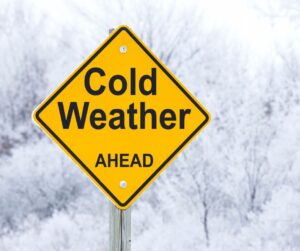
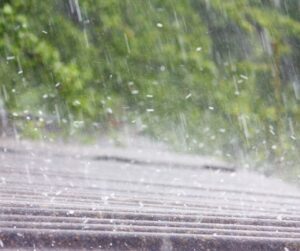 rain, snow, and hail. It’s also durable enough to resist impact, making it a good option for areas with heavy foot traffic or potential hazards.
rain, snow, and hail. It’s also durable enough to resist impact, making it a good option for areas with heavy foot traffic or potential hazards.